A Special Kind of Robotics
Gail K. Tate shares about a unique educational program targeting children with special needs.
Shaindle Schmuckler spreads her energy and humor as a regular contributor to the Atlanta Jewish Times.
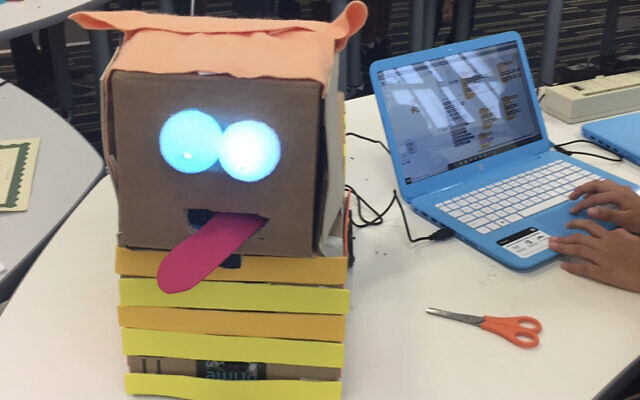
All our children deserve the opportunity to learn the magic of new, innovative and unique thought. Introducing the fusion of engineering and creativity to the widest spectrum of children, including those who are visually impaired, is Gail K. Tate’s mission.
Typically, not all students have access to STEAM (science, technology, engineering, arts, and maths) education. Here is one unique program, hosted by Tate and sponsored by Georgia Institute of Technology. This program is making waves in the world of education and encourages children, including ones with special abilities and challenges, to participate in a creative, engineering-based curriculum that everyone can enjoy.
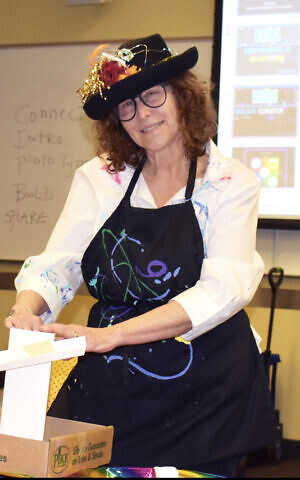
The AJT asked Tate to discuss the ins and outs of the program…
AJT: How and why did you get into teaching STEAM programs for children and teachers in the first place?
Tate: As early as I can remember, I was creating art, sculpture and making music. My parents always encouraged creativity. Oddly, they did not imagine young girls could ever aspire to a profession in technology, engineering, or science. Ironically, I launched a 35-year career in technology, project engineering and sales. Nonetheless, I was hungry for a more authentic and purposeful life’s work! I felt, in my bones, that I was supposed to launch a new adventure. Does fate have a strange way of finding us? I decided to do some hunting at an education trade show and found a robotics company that combined computer coding, engineering, and art! It was love at first robot…and fast forward to 2013 when AVEZ Select was born (www.avezselect.com). My passion to bring technology to a wider range of students and educators became my second career. What if I could inspire children to love engineering and robotics, who typically would never imagine themselves as participating in STEAM programming?
AJT: When did you have this idea?
Tate: For many years I was restless in working for large technology corporations. I was grateful for the lifestyle it afforded us…but felt something was missing. When I found the opportunity to escape, I took it!
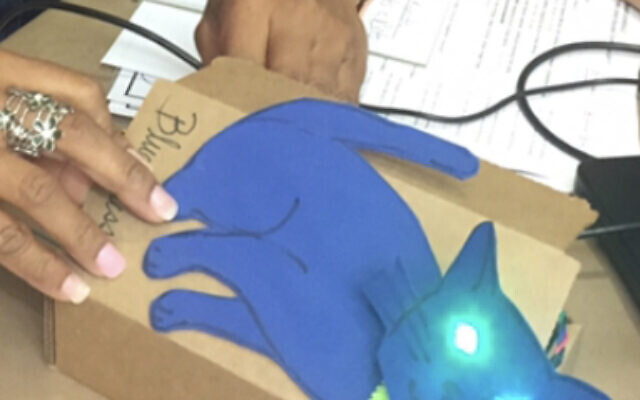
AJT: Have you taught robotics and engineering curriculum to other groups?
Tate: Teaching ARTBotics and STEAM programs is a wild ride! Since 2016, I have been collaborating and subcontracting for Georgia Tech’s children’s programs. Together, we have brought our unique ARTBotics and Mechanisms programs to Fulton County schools, High Museum of Art, Horizons Atlanta, summer camps, and more. In addition, since 2013, AVEZ Select’s workshops have been hosted as far away as China, San Francisco, Texas, North & South Carolina, and Georgia. Pre-COVID, I have had the luxury of hosting programs at the MJCCA. This summer, we will be starting our programs at the Spruill Center for the Arts.
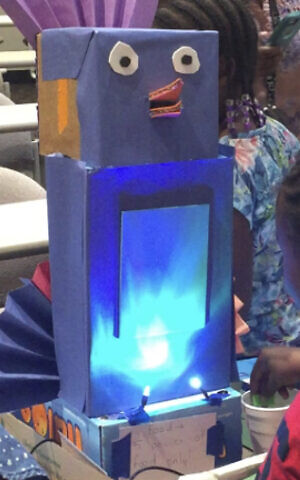
AJT: What precipitated your devoting so much time and energy to creating STEAM classes and workshops?
Tate: It is essential that we bring technology to children who don’t have access to it, or don’t think they are capable. Blending the arts with engineering is less intimidating. I have witnessed even the most resistant students become passionate about creating computer programmed creatures or building mechanical toys. The power of integrating imagination and design into every project has remarkable results. Recently, I was approached with a new challenge to bring STEAM programs to middle school students who had limited sight or were completely blind. The Center for the Visually Impaired (www.cviga.org) was talking with Georgia Tech’s leadership and I was brought into their conversations. These children should have opportunities to discover their inner inventor, too! Why not introduce them to engineering? To prepare, I looked for prior STEAM projects for this special group but could not find any substantial resources for hands-on building. It was time to create our own solution! My strategy was to focus on their ability to be visionaries for future technology. The goal is encouraging their special abilities to be an asset and not a liability.
AJT: What are the differences/challenges preparing for visually challenged as opposed to sighted students?
Tate: The obvious challenge is the children are working with their hands without being able to completely see the results. Touch and sound are very important. I set the expectation that their hands and fingers were as important as eyes for sighted engineers.We set up the classroom in a totally different format. About 90 percent of the tables and chairs were pushed to the side. I wanted the students to feel safe (and not make the room treacherous).
In addition, I pre-made individual packages so that it was easy for them to understand what supplies they had. I recruited Publix and Pike’s Nurseries to donate bags and boxes so that their supplies wouldn’t ‘roll away’ and they could keep track of their building materials. The way I adapted our curriculum was laborious (but worth it!). I took prior STEAM classes that I have taught and broke it down to simpler steps. Instead of using braille for instructions, I developed a system by adding a hole pattern into the craft materials. We specified art supplies that had a variety of textures that were easy to identify by touch. Our building tools also included ways to add sound and movement to their creations. Each project was separated into three phases:
1) The first was to build a prototype.
2) The second was to improve on what they learned and build the final creation.
3) Part three was where the students presented at the end of the program (to their parents).
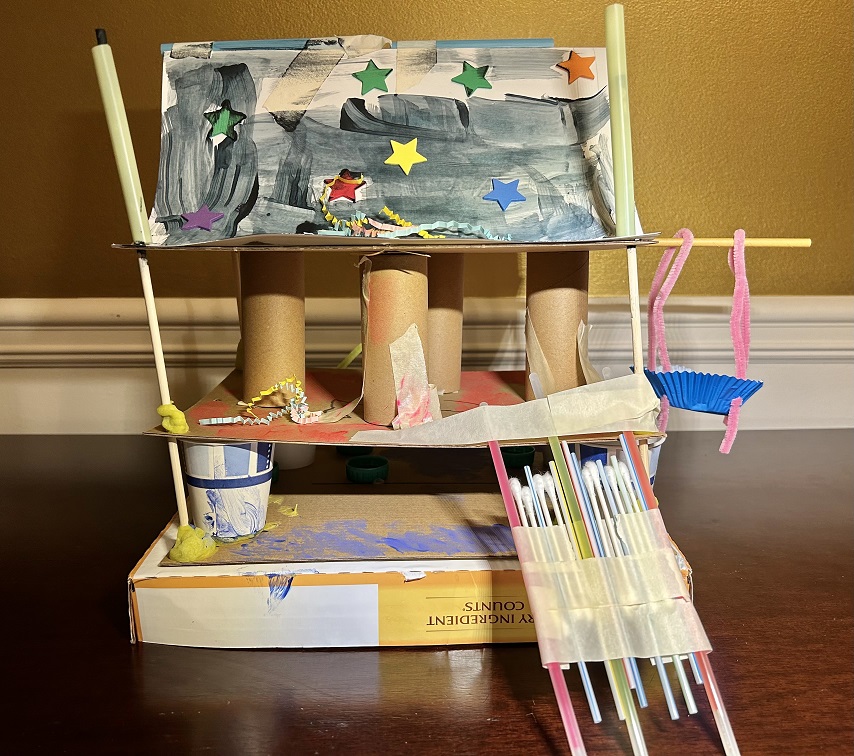
“I believe it is important to encourage these skills alongside the engineering process. We have launched two classes so far. The first was “Build a Dream Home.” Here, I encouraged them to share their perspective on designing a house for people with special abilities. We introduced construction technology and the types of engineers required to make a building.
“Our recent program was to “Create a Rock-n-Roller Coaster.” Their challenge was to start with building one tower, one track, and get a marble to drop into a cup. It’s harder than it sounds! Their smiles when hearing the sound of the marble speeding into the cup was priceless. Developing community is essential in our workshops.
“We encourage conversation – for example: what was their experience at an amusement park? What design changes would they make for people of all abilities at roller coaster parks? Of course, we made it fun with lots of music and imagination exercises. Their projects were amazing. I’d like to share a big shout out to Georgia Tech and the Center for the Visually Impaired for taking on this challenge.”
For more information, contact Gail K. Tate, AVEZ Select, LLC at gailktate@avezselect.com.



comments